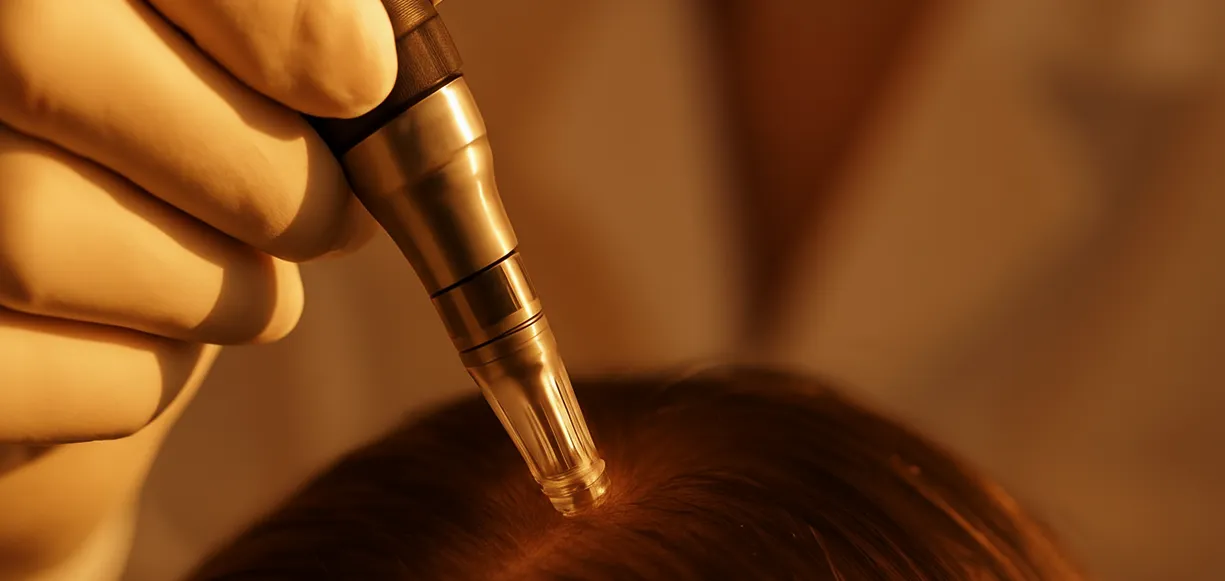
We’ve been conditioned to believe that hair growth comes from the latest serum, supplement, or miracle formula in shiny packaging. But what if the real secret isn’t in a product at all, but in how you nudge your scalp to wake up dormant follicles?
Microneedling, the same treatment once confined to skincare clinics has quietly stepped into the hair restoration spotlight. It’s being praised not as a replacement for minoxidil or PRP, but as the partner that makes them work smarter, not harder. Still, can poking tiny holes in your scalp really outdo creams and capsules?
Let’s uncover what the science says and whether your follicles actually need a little controlled chaos to grow stronger.
Curiosity alert: tiny needles, big regrowth?

Hair loss doesn’t happen overnight.
It begins deep within the follicles where growth cycles are disrupted. Each hair follicle cycles through three main phases: growth (anagen), regression (catagen), and rest (telogen). In most forms of alopecia, this cycle is interrupted. In androgenetic alopecia, hormones like dihydrotestosterone (DHT) shrink hair follicles, shortening the anagen phase and thinning each new strand. In alopecia areata, an overactive immune system attacks follicles, causing sudden bald patches. Both conditions lead to reduced blood flow, local inflammation, and poor communication between follicular cells and their growth environment (Healthline, 2018; ScienceDirect, 2023).
Microneedling enters this picture by strategically reactivating these dormant systems. Each tiny puncture works as a micro-signal that triggers healing and regeneration. These controlled micro-injuries activate stem cells in the hair bulb and dermal papilla—the follicle’s “command center” for hair growth and release growth factors such as VEGF and IGF that promote new blood vessel formation and nutrient delivery. This process also improves the penetration of topical agents like minoxidil or platelet-rich plasma, amplifying their effect (Fertig et al., 2018; Zhang et al., 2025). The stimulation wakes follicles that have fallen asleep during prolonged rest phases and reboots them into active growth.
Recent studies show microneedling can improve hair density by 30–40% when combined with conventional treatments, proving it’s not a standalone miracle but a potent ally. For androgenetic alopecia, it restores blood flow and counteracts follicle miniaturization, while in alopecia areata, evidence suggests it helps recalibrate immune responses and even balance the scalp microbiome (Frontiers in Microbiology, 2025; Cleveland Clinic, 2023). In essence, microneedling bridges biology and technology, turning controlled trauma into a new start for struggling follicles.
Microneedling isn’t a one-and-done miracle. Its success comes down to consistency, pairing, and precision. When used under the guidance of a dermatologist or trichologist, it’s considered one of the safest and most effective adjuncts to conventional hair therapies in 2025.
Here’s how to make it work best:

Combine microneedling with proven topicals like 5% minoxidil or PRP sessions for maximum regrowth results.
Schedule sessions every 1–2 weeks initially, then shift to monthly maintenance based on results.


Professional devices generally outperform at-home rollers due to precise depth control and sterile application.
While home rollers can be tempting, research warns that improper use increases infection risk and uneven absorption of topicals. Always check needle length (ideally 0.5–1.5 mm) and technique. Clinics, on the other hand, offer electrodynamic and motorized tools that enhance uniform penetration without skin trauma.
In short, professional microneedling treatments offer a strategically safer, more effective route especially when combined with expert monitoring for long-term gains.
Real regrowth isn’t flashy; it’s patient. The first few weeks test your doubts, shedding before sprouting. But by the time tiny baby hairs appear, you start realizing what consistency really means. Microneedling won’t hand you instant miracles it hands your follicles a reason to fight again. And maybe that’s the point: sometimes progress isn’t loud, it just quietly grows back stronger, one prick at a time.